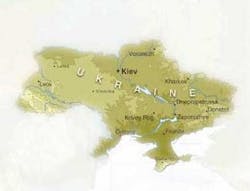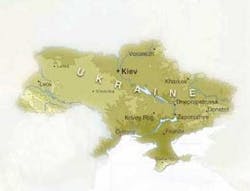Laser technologies in Ukraine
Ukraine is an Eastern European country, neighboring on Russia, Belorus, Poland, Slovakia, Hungary, Romania and Moldova. It is rich in natural resources: coal, iron, manganese (the largest deposits in the world), nickel, chromium, titanium, mercury (second largest in the world) and graphite deposits (largest in Europe). One quarter of the world's black soil is in Ukraine. And it is also a sea country on the Black Sea, which connects it to the world's oceans. In land area it is 603.7 thousand sq.km. (About 5.7 percent of Europe), which makes it larger than France, Spain, Sweden, Germany and Poland. The population is 49.5 million (fifth in Europe after Germany, Italy, UK and France), about 7.3 percent of Europe's population.
Ukraine is a developing European state, and despite its diminished economy in the last few years, this country has considerable resources in industrial and intellectual potential. The country has a strong position in heavy machine building, metallurgy and shipbuilding. Ukraine produces cars, buses, agriculture machines, aviation engines and planes and equipment for the power, oil and gas industries. Ukraine is also an important manufacturer of tanks, planes, missiles and optical systems (the third largest seller of weaponry after the USA and Russia). The volume of external trade in 2000 was $33.4 billion, but the Gross Internal Product (equivalent to GNP) in 2002 declined to approximately $32 billion.
Ukrainian scientists conducted their first research in the field of quantum electronics in the mid-1950s. Studies in laser materials processing started in 1964 at the Kiev Polytechnic Institute (KPI) with the study of laser piercing small diameter holes in different materials.
A number of basic institutions grouped under the Institutes of the National Academy of Sciences of Ukraine (NASU) became interested in this field of science and engineering: Paton Institute of Electric Welding; Institute of Physics; Institute of Problems of Materials; Institute of Super Hard Materials; Physical Engineering Institute of Metals; Institute of Metals Physics; Institute of Physics of Semiconductors; Institute of Electrodynamics; Institute of the Optical Information; Institute of Problems of Materials Strength and about 20 others.
There are also a number of universities and branch institutes working in this field: National Technical University of Ukraine (Kiev Polytechnic Institute); National University (Lvivska Polytechnika); Kharkov State University; Kiev Shevchenko National University; National Kharkov Polytechnic University; Kharkov Aviation University; Uzhgorod State University; Odessa State University; Mykolaiv Shipbuilding Research Institute; Research Institute ARMA and about 25 others.
About three-dozen industrial companies and job shops use industrial laser technology. Among them are: the Malyshev Tank Company, Bolshevik Company, Motorsich Company, Progress Company, Arsenal Company, Kirovgeologia Company, Kraz Company, Yuzhmash Company, Emerald Company, Lviv-Electronics Co. Ltd, Job Shop Bass-Laser, Joint Venture Apogee, Joint Venture Excimer, Mitar Co. Ltd. and 30 others.
Research efforts study the mechanisms of laser radiation interaction with different materials, development of basic processes of laser materials machining and special industrial laser systems and units. This activity is performed within the scientific programs framework of the Ministry of Science and Education, Ministry of Industry, Coordination Plans of NASU and different initiative programs at specific institutions. The most active work is in precision hole drilling, cutting, machining slots, scribing, hardening, alloying, cladding, welding, 3D component synthesis, marking and engraving. Hardware developments are progressing in special optics, the manufacture of laser industrial systems, new laser types, the development of laser power supplies and the development of laser systems for medical purposes, information technology, entertainment and laser devices for special purposes.
Process developments
Several successful process developments stand out, including a high-performance, automated laser system for piercing numerous holes in plane components at the Kiev Airplane Plant (KIAPO). Laser hardening of the large-sized tools used in the manufacture of oil and gas equipment is done at the Bolshevik Company, a specialized laser job-shop. Laser hardening of the interior working surfaces of three-meter-long slides for equipment used to manufacture thin polymeric films has eliminated a labor-consuming and expensive high-frequency induction process. The laser hardening process produces a considerable saving in energy while avoiding subsequent grinding after heat treatment.
KPI engineers have developed techniques to increase the wear resistance of cutters, drills and end mills, and components of dies and molds at S.P. Korolev Company, Bolshevik Company, Arsenal Company, Artema Company and others.
Lasers have been used at Malyshev Tank Company to harden cylinder liners, crankshafts and other large-sized components for truck diesel engines and diesel locomotives, and today Bolshevik Company manufactures components for escalators used in the metro and underground supermarkets, railway stations and airports.
Laser welding research and development and the development of equipment for welding has been successfully carried out at the Paton Institute for many years. Recently they began conducting research in the field of hybrid laser welding, developing a laser-plasma process with the laser beam inserted coaxially into the plasma torch.
The Mykolaiv Research Institute for Shipbuilding has implemented techniques and equipment for laser cutting of sheet metal material for the shipbuilding industry. Based on their capabilities, the Ukrainian regional center of LAS (Moscow) had been opened there.
In 1972, KPI and the Kiev Emerald Company began a study of machining natural diamonds for the jewelry industry. As a result, techniques for laser scribing and cutting of natural diamonds now allows processing to be reduced by a factor of two, contrasted to the traditional methods. This advanced technology, implemented in all the diamond machining factories of the former USSR, is being developed further for the benefit of two diamond jewelry manufacturers in Kiev and Vinnitca.
The Laser Technology Research Institute (LTRI) in cooperation with Aerospace Research Institute have developed a robotized system for laser machining of work pieces for the aerospace industry. This system integrates a solid-state Nd:YAG laser with beam delivery via a flexible fiber to the focusing device fixed at the end effector of an anthropomorphic robot. This system is being used for high efficiency and quality cutting of composite materials.
This experience has been useful in solving the problem of remote disintegration at the Chernobyl Atomic Station. The laser beam can be used to cut off devices destroyed in deconstruction, for temporary welding to secure against future operations, and for fixing the radioactive dust on the surfaces of metal or concrete constructions. The principal advantage of the laser is the possibility to transmit the beam from the source, over considerable distances (>100 µm), via flexible fiber. LTRI researchers together with the experts of the Research Institute of Applied Mechanics Rhythm have developed a robotized laser system with a 400W Nd:YAG laser and options to increase power up to 800 W. Experimental trials for cutting cooling tubes 500 mm in diameter have shown positive results.
Equipment manufacturers
In the past, the main suppliers of industrial laser systems were from Russia. Some specialized equipment was designed and manufactured by Paton Welding Institute, LTRI, Mykolaiv Shipbuilding Research Institute, Malyshev Tank Company and others. Now the supply is unstable, and demand exceeds supply. There are about 1000 industrial laser systems in operation in Ukraine now, many of which are outdated and need modernization or removal. The potential market for the near term is estimated at a few hundred units, with a tendency for intense growth when the economy recovers.
A few CO2 laser systems have been purchased from companies in Britain and Switzerland, and one system for rapid prototyping using stereolithography process has been bought from the USA. There is a strong demand for modern industrial laser systems using different laser types. But, because of financial problems and lack of foreign currency, some enterprises prefer leasing or gradual payments.
University programs
Since 1984, at KPI an engineering curriculum in laser processing has been in place. Now, the title of this program is known as "Materials Processing with Special Technologies," with two subsets: "Equipment and Technologies for Laser Processing" and "Laser Systems for Medicine and Biology." In the last decade more than 450 engineers and 40 masters in engineering were taught laser technology and have been granted the corresponding degree.
Publications and patents
In the field of lasers and laser technology, Ukrainian experts have published more than 30 monographs, textbooks and manuals. Some of them have been reprinted in Russia, USA, Bulgaria, Peoples Republic of China, Jordan and other countries. More than 350 copyright certificates on the inventions and patents in the field of laser technology belong to Ukrainian authors. All together there are more than 1500 scientific papers of Ukrainian experts published in different professional journals in the field of lasers and laser technology.
International contacts
Today Ukrainian scientists participate in the activities of different international professional institutions: CIRP (Paris), IEEE (New York), LIA (Orlando), LEOS (New York), SPIE and LAS (Moscow). Scientific papers have been presented at international conferences, held abroad, and after a long interval a new international conference has been initiated in Ukraine itself.
Prof. Volodymyr S. Kovalenko is the director of Laser Technology Research Institute of the NTUU "Kiev Polytechnic Institute" and head of the Laser Technology & Material Science Department of this university. Contact him at e-mail [email protected].

